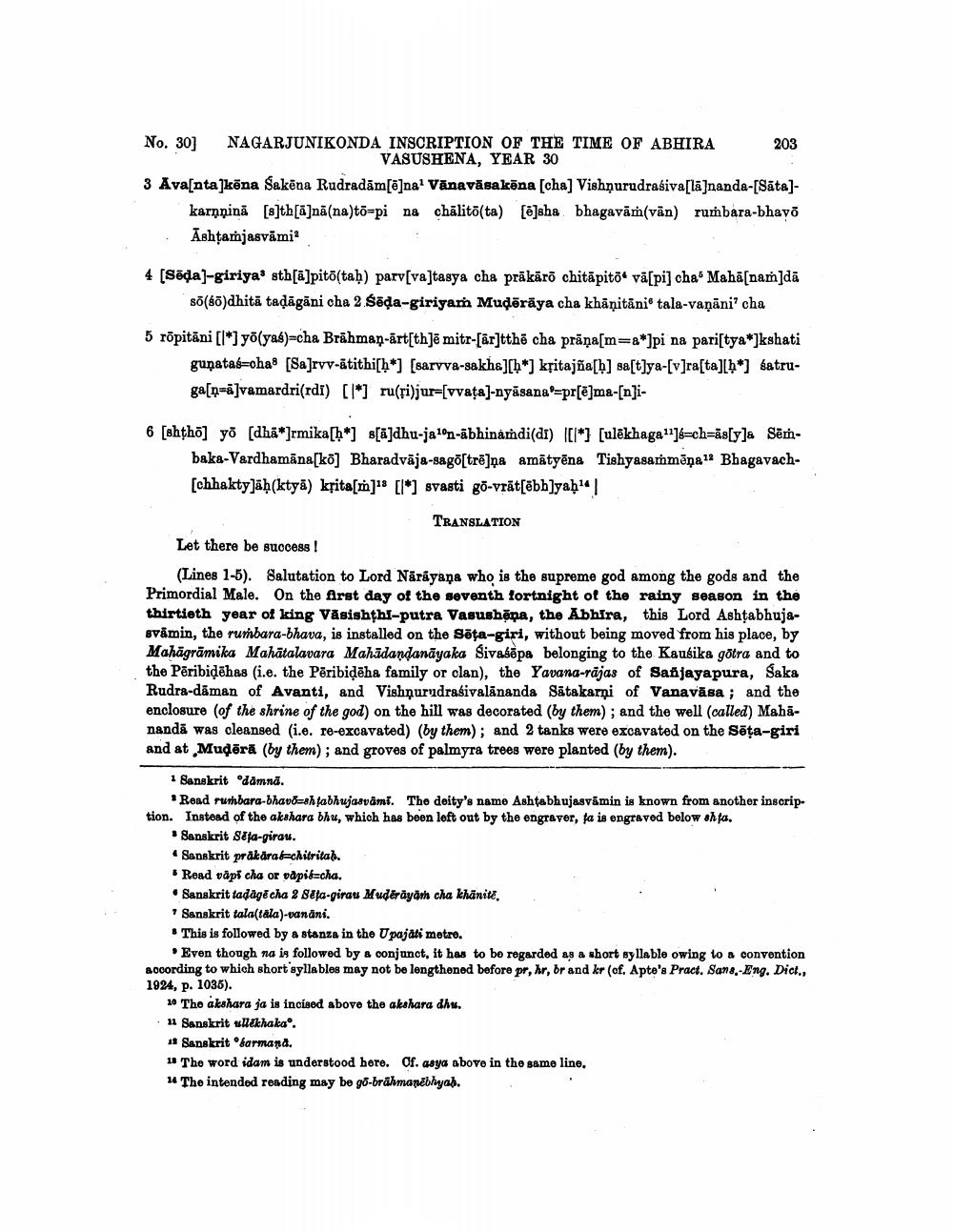________________
203
No. 30] NAGARJUNIKONDA INSCRIPTION OF THE TIME OF ABHIRA
VASUSHENA, YEAR 30 3 Ava[nta]köna Sakēna Rudradām[@]nal Vānavāsakāna [cha] Vishņurudrasiva[lā]nanda-[Sāta)
karņņinā [s]th[ā]nā(na)to=pi na chālitā(ta) [è]sha bhagavāṁ(vān) rumbara-bhayo Ashtamjasvāmi
4 [Sēda]-giriya sth[@]pitõstaḥ) parv[va]tasya cha prākāro chităpitõi vä[pi] cha Mahā[nam]dā
sõ(57)dhitā tačāgāni cha 2.Śēda-giriyam Mudērāya cha khānitāni tala-vaņāni' cha
5 rõpitāni [l*) yõlyas)-cha Brāhmaṇ-ārt[th]ē mitr-[ār]tthi cha prāņa[m=a*]pi na pari[tya*]kshati
guņatas=ha8 [Sa]rvv-ātithi[h*] (sarvva-sakhe][h*] kritajña[h] sa[t]ya-[v]ra[ta][h*] katruga[ņ=ā]vamardri(rdi) [1*] ru(ri)jur=[vvata)-nyāsana!=pr[ē]ma-[n]i
6 [shthö] yo [dhā*]rmika[h*] s[ājdhu-jalon-ābhinamdi(di) |[l*1 [ulēkhaga"]s=ch=ās[y]a Sēm
baka-Vardhamāna[ko] Bharadvāja-sagõstrē]ņa amātyēna Tishyasammēņa 12 Bhagavach[chhakty]āḥ(ktyā) krita[m]"* [l*) svasti go-vrät[ēbh]yaḥ|
-
TRANSLATION
Let there be success!
(Lines 1-5). Salutation to Lord Nārāyana who is the supreme god among the gods and the Primordial Male. On the Arst day of the seventh fortnight of the rainy season in the thirtieth year of king Väsishthi-putra Vasushēna, the Abhira, this Lord Ashtabhujasvāmin, the rumbara-bhava, is installed on the Sēta-giri, without being moved from his place, by Mahāgrāmika Mahätalavara Mahādandanāyaka Sivasēpa belonging to the Kausika götra and to the Pēribidēhas (i.e. the Pēribidaha family or clan), the Yavana-rajas of Sanjayapura, Saka Rudra-dāman of Avanti, and Vishnurudrašivalānanda Satakarni of Vanavāsa ; and the enclosure of the shrine of the god) on the hill was decorated (by them); and the well (called) Mahānandā was cleansed (i.e. re-excavated) (by them); and 2 tanks were excavated on the Sēta-giri and at Mudērā (by them); and groves of palmyra trees were planted (by them).
1 Sanskrit damna.
Read rumbara-bhavdoshtabhujasvami. The deity's name Ashtabhujasvamin is known from another inscription. Instead of the akshara bhu, which has been left out by the engraver, ta is engraved below shfa.
* Sanskrit Séta-girau.
Sanskrit präkärakchitrital. * Read vāpi cha or vàpid=cha. • Sanskrit tadagi cha 2 Béta-girau Mudêräyönh cha khänitt. * Sanskrit tala(tala)-vanāni. . This is followed by a stanza in the Upajati motro.
. Even though na is followed by & conjunct, it has to be regarded as a short syllable owing to a convention according to which short syllables may not be lengthened before pr, hr, br and kr (of. Apte's Pract. Sans-Eng. Dici., 1924, p. 1035).
10 The akshara ja is incised above the akshara dhu. 11 Sanskrit uuekhakao. 11 Sanskrit &armana. 11 The word idam is understood here. Of. asya above in the same line.
The intended reading may be go-brähmanēbhyah.




